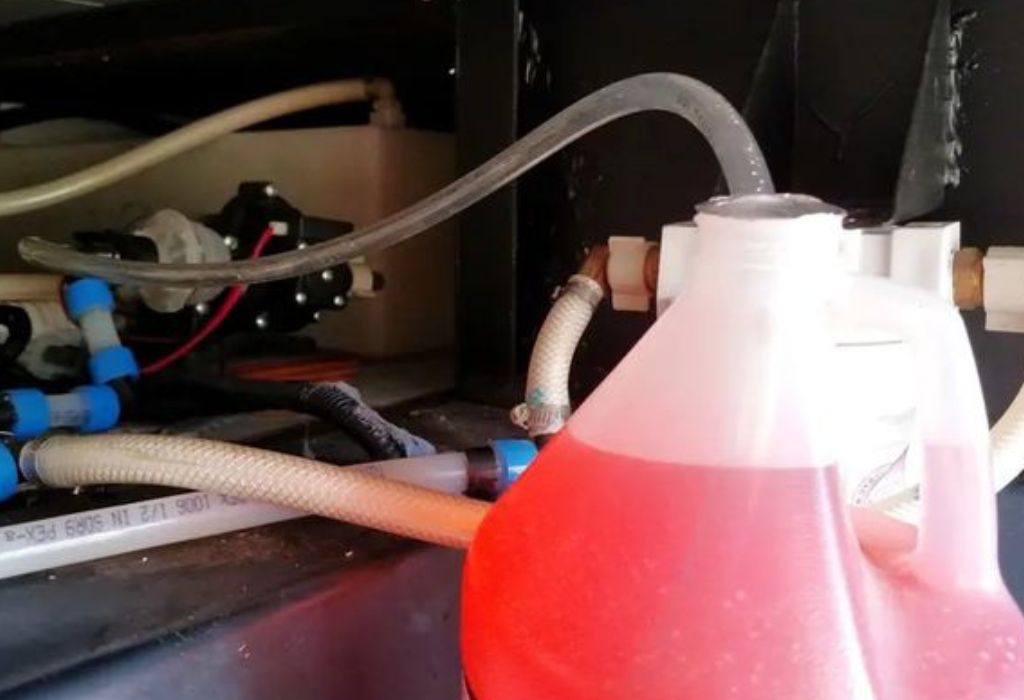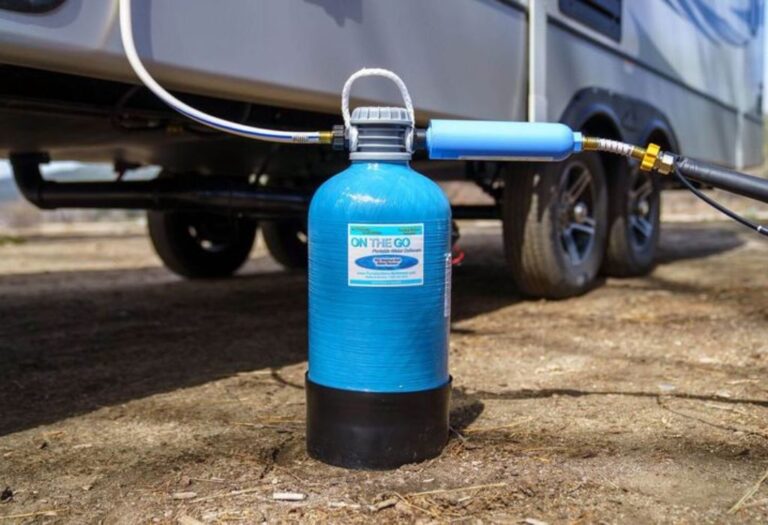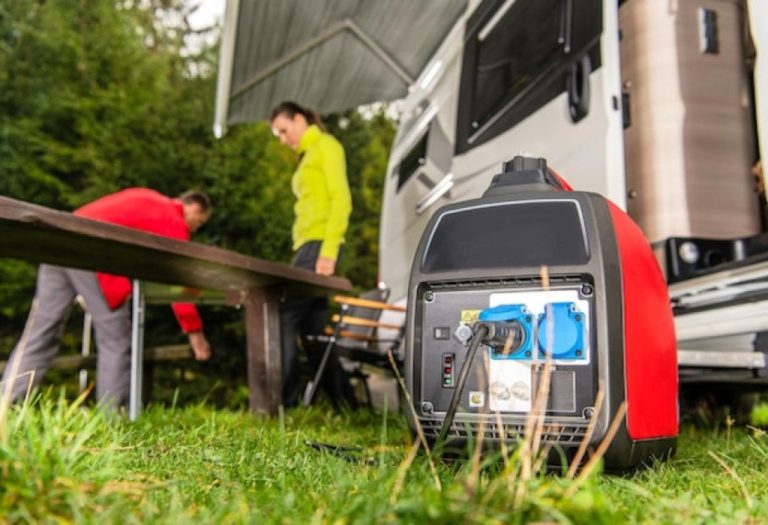How Much RV Antifreeze Per Gallon of Water?
When temperatures drop below freezing, thousands of RV owners face the same chilling question — how much RV antifreeze per gallon of water is actually needed to protect their plumbing system?
Frozen water lines are more than just an inconvenience. A single burst pipe in an RV can cost over $1,000 in repairs, according to RV Life Magazine. That’s why using the correct amount of RV antifreeze is not guesswork but a crucial part of winter preparation.
Many first-time owners believe draining the system is enough. Unfortunately, even a few ounces of trapped water can expand by up to 9% when frozen, cracking pipes, fittings, and valves. The result? A costly springtime surprise.
RV antifreeze offers a simple and affordable way to prevent this disaster. It flows through the entire plumbing system, replacing leftover water and protecting lines, pumps, and tanks from freezing damage. But confusion arises when owners try to determine how much antifreeze is needed per gallon of water in their system.
Every RV is different. A compact travel trailer might use just 2 gallons, while a large fifth-wheel could require 4 or more, depending on layout and whether the water heater is bypassed. Understanding these differences is key to ensuring full coverage without waste.
This guide breaks down the exact factors that determine the right amount of antifreeze per gallon of water, helping you winterize efficiently and avoid costly damage when temperatures plummet.
Understanding RV Antifreeze and Water Systems

Before deciding how much RV antifreeze per gallon of water you need, it’s essential to understand how your RV’s plumbing system works.
An RV’s water system is a network of tanks, lines, faucets, valves, and pumps that deliver fresh water and remove waste. These components are exposed to outdoor temperatures, making them highly vulnerable to freezing in winter.
RV antifreeze is a specially formulated, non-toxic solution designed to prevent this damage. Unlike automotive antifreeze, it’s safe for potable water systems and won’t leave harmful residue inside pipes.
According to industry data, frozen plumbing is one of the top three causes of winter RV damage in North America. That’s why antifreeze is not optional — it’s a seasonal necessity.
RV antifreeze works by lowering the freezing point of any remaining water in your plumbing system. When pumped through lines, it creates a protective barrier that keeps pipes and fittings from bursting, even in sub-zero temperatures.
What exactly is RV antifreeze?
RV antifreeze is a propylene glycol or ethanol-based liquid designed for RV plumbing systems. It prevents residual water from freezing and damaging lines or fixtures.
Why not just drain all the water instead of using antifreeze?
Draining removes most water, but small pockets always remain in valves, pumps, and traps. These can freeze, expand, and cause cracks when temperatures drop.
Can you use regular automotive antifreeze in an RV?
No. Automotive antifreeze contains toxic chemicals like ethylene glycol, which are unsafe for drinking water systems and harmful to seals and fittings.
What parts of the RV plumbing system need protection?
The freshwater tank, water lines, P-traps, water heater, and holding tanks all need antifreeze coverage. Each section has different exposure points to freezing.
At what temperature should you start winterizing your RV?
Once temperatures consistently drop near 32°F (0°C), it’s time to winterize before the first hard freeze. Delaying even a few nights can lead to costly repairs.
How Much RV Antifreeze Is Needed Per Gallon of Water?
The amount of antifreeze per gallon of water varies because every RV has a unique plumbing layout. There is no single universal ratio that works for all rigs.
Most RVs use about 2 to 4 gallons of antifreeze total, not a set amount per gallon of water. The total depends on the system’s length, the number of fixtures, and whether the water heater is bypassed.
Smaller trailers with simple plumbing systems require less antifreeze, while larger fifth-wheels or motorhomes may need more due to extra water lines and fixtures. The key is ensuring the antifreeze fully replaces all water in the lines.
Is there a simple ratio like one gallon of antifreeze per X gallons of water?
No. Ratios vary because the goal is full replacement of water, not dilution.
What is a typical range for most RVs?
On average, 2–4 gallons of RV antifreeze will winterize a mid-size camper or motorhome.
What factors increase antifreeze usage?
RV size, number of water fixtures, no bypass valve on the water heater, and longer pipe runs all increase total volume needed.
What if your freshwater tank still has water?
You’ll need significantly more antifreeze to push out or dilute remaining water, making the process inefficient.
Can you just pour antifreeze down the drains instead?
Yes, small amounts should go into each sink, shower, and toilet to protect P-traps and holding tanks from freezing.
Example Volume Scenarios by RV Size
Different RV sizes require different antifreeze amounts. The layout, tank size, and plumbing complexity all influence total use.
Small travel trailers (under 20 feet):
Typically require about 2 gallons of RV antifreeze to cover all lines and drains.
Mid-size trailers or Class C motorhomes:
Often need 3–4 gallons, depending on the number of water outlets and whether a bypass valve is installed.
Large fifth-wheels or Class A motorhomes:
May require 5–6 gallons or more, especially if the water heater cannot be bypassed.
Compact trailers:
Usually need only 2–3 gallons since plumbing is shorter and fewer fixtures exist.
Should you add antifreeze to the holding tanks?
Yes, pour at least one quart into each gray and black tank via drains or toilets to prevent residual water from freezing.
Step-by-Step Winterizing Process Using Antifreeze
Winterizing is straightforward when done methodically. The process ensures every pipe, trap, and tank receives antifreeze coverage.
Step 1: Drain the freshwater system.
Open low-point drains and empty the water heater. This removes as much water as possible before adding antifreeze.
Step 2: Bypass the water heater.
Use a bypass kit to prevent filling the 6–10-gallon water heater tank with antifreeze, saving several gallons.
Step 3: Pump antifreeze into the system.
Connect the suction hose to a jug of antifreeze and use the onboard water pump to draw it through the lines.
Step 4: Open faucets one at a time.
Run each faucet until pink fluid appears. Don’t forget outdoor showers and low-point drains.
Step 5: Protect P-traps and tanks.
Pour about 1–2 cups into every sink and shower drain, and 2–4 cups into the toilet.
Step 6: Shut off the pump and close faucets.
Ensure pressure is released and lines are full of antifreeze, not air.
Step 7: De-winterize in spring.
When temperatures rise, flush all antifreeze out and sanitize the system before use.
Common Mistakes and How to Avoid Them
Even experienced RV owners make mistakes during winterizing. A few small errors can lead to costly damage when temperatures fall.
Diluting antifreeze with water
Mixing antifreeze with water reduces its effectiveness and lowers freeze protection. Always use full-strength RV antifreeze.
Using automotive antifreeze
Never substitute car antifreeze. It contains ethylene glycol, a toxic chemical that contaminates potable systems and damages seals.
Forgetting exterior lines or outdoor showers
External faucets, sprayers, and outdoor showers freeze quickly because they’re exposed to cold air.
Not bypassing the water heater
Failing to bypass wastes several gallons of antifreeze and leaves the tank full of pink fluid that must later be drained.
Not checking for leaks afterward
Once antifreeze is pumped through, inspect for drips or weak fittings to ensure no air gaps or pressure leaks remain.
How to Determine the Right Amount for cYour RV

Estimating how much antifreeze your RV needs isn’t difficult when you follow a checklist. The goal is complete protection, not minimal coverage.
Check your system size.
Longer plumbing systems or large Class A motorhomes naturally require more antifreeze.
Verify the presence of a water-heater bypass.
If installed, you can save 6–10 gallons of antifreeze. Without it, the entire heater tank must be filled.
Count your fixtures.
Each sink, shower, or outdoor spigot adds extra lines that require fluid.
Plan for holding tanks.
Add at least one quart per tank to protect waste valves and traps.
Buy extra antifreeze.
Always purchase one additional gallon as a safety buffer. Antifreeze is inexpensive compared to potential plumbing repairs.
Should you reuse old antifreeze?
No. Use fresh product each winter for maximum protection.
Are there online calculators?
Yes, some manufacturers provide antifreeze calculators based on plumbing volume.
Conclusion
There’s no fixed rule for how much RV antifreeze per gallon of water you should use. Each RV’s plumbing system is different, but most owners need about 2 to 4 gallons of antifreeze for complete protection.
Choosing RV-specific, non-toxic antifreeze ensures safety for your water system while preventing expensive freeze damage.
A little preparation today saves thousands in repairs tomorrow. Always winterize before freezing weather hits, follow the correct steps, and double-check that every line, faucet, and drain is filled with antifreeze.
By understanding your RV’s plumbing layout and using the right amount of antifreeze, you can store your vehicle with confidence — ready to roll again when warmer days return.
I’m David R. Coleman, the founder, lead writer, and lifelong tool enthusiast behind GarageToolPro.com. With years of experience in automotive repair, woodworking, and home DIY projects, I created this platform to share practical tips, detailed tool reviews, and step-by-step guides that help mechanics, hobbyists, and homeowners get the job done right the first time.






